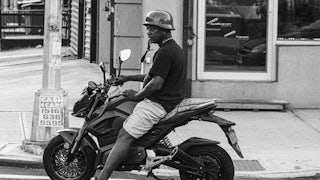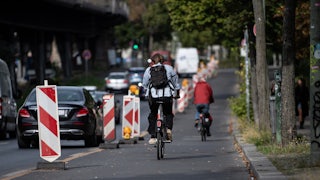Fires and overheating accidents attributed to lithium-ion batteries killed 19 people in the United States in 2022, according to the U.S. Consumer Product Safety Commission. In New York City alone, six people died in these uniquely fast-burning infernos. Experts say poorly made batteries, like those often found on cheaper e-bike models, are the primary culprit. So why is it still so easy to purchase them? Does a typical bike owner know how to safely charge and maintain a bike battery? And are lower-paid workers, such as delivery people, essentially being forced to purchase unsafe bikes just to be able to do their jobs? On episode 59 of The Politics of Everything, hosts Laura Marsh and Alex Pareene talk with writers Greg Smith, Stephanie Clifford, and Ross Barkan about the New York fires and the populations most at risk, the regulatory challenges of reining in the e-bike industry, and the unintended consequences of our on-demand culture.
CBS New York news clip: New information on a deadly fire in the East Village that left two teenagers clinging to a pole, trying to escape the flames. Investigators now believe e-bike batteries caused the fire.
Laura Marsh: Last year in New York alone, e-bike batteries caused 202 fires, 142 injuries, and six deaths.
Alex Pareene: But it’s not just here. According to a recent story in Consumer Reports, an electric bike battery started a garage fire in Bend, Oregon. In Utah, a charging bike started a fire in a retirement community. In Baltimore, an e-bike set an apartment garage on fire.
Laura: I was really surprised to hear about these fires. You see people riding e-bikes all over the city, especially delivery workers.
Alex: As e-bikes have become more common, so have these fires. Is that because the bikes are inherently dangerous? Is the solution just to ban them?
Laura: Today on the show, we’re talking about why the batteries have been exploding, how the pandemic made fires more common, and what would actually prevent them. I’m Laura Marsh.
Alex: And I’m Alex Pareene.
Laura: This is The Politics of Everything.
Laura: On November 5, a fire broke out on the twentieth floor of a luxury apartment building on East 52nd Street in midtown Manhattan. Inside, firefighters found five e-bikes and that the fire came from the bikes’ lithium-ion batteries. Forty-three people in the building were seriously injured, and two were in life-threatening condition. Greg Smith covered the story for the nonprofit news organization THE CITY, and he’s joining us today to talk about the disaster. Greg, can you give us a sense of just how bad this fire was?
Greg Smith: The e-bike batteries, when they explode, are really hard to put out. Because it’s essentially a chemical fire: You throw water on it, the chemicals move around, and that’s about all that happens. And so for these people, the only way to get out was to climb out these windows. There are no fire escapes on this kind of building. So the Fire Department had to do this crazy rescue thing where they went into the apartment above and then rapelled down and pulled these people out. The other problem, of course, is smoke. This smoke just went throughout the building very, very quickly. Again, these fires are really fast. It went rocketing across the twentieth floor. People were trying to get out, they were going down the staircase that opens the door up. The door then becomes a chimney and it sucks the smoke into it. And so it was a pretty crazy fire, basically. It went roaring through the building very quickly.
Laura: And you mentioned a little bit about how e-bike battery fires are different from a lot of fires that might break out in an apartment. You might have a space heater or an extension cord that causes a fire, and that’s a really bad situation, but this is different by an order of magnitude.
Greg: It’s funny that you’ve just brought up space heaters. One year ago, I think today, there was a really terrible fire in the Bronx called the Twin Parks. In that case, a lot of people died. And in that case, it was a space heater. But guess what else was in the apartment with the space heater.
Alex: Lithium-ion batteries?
Greg: Correct.
Laura: Oh, wow.
Greg: So that exacerbated the fire, made it go, again, very fast. And then it sent smokes throughout the building. That was a disastrous fire. The Fire Department has been, they will send this crazy video out of one of these things erupting, and you can see, it just blows the top off of it. It looks like a volcano. And then they throw water on it and nothing happens. It’s almost like a bomb.
Alex: The residents in that building knew this was a problem and had been trying to stop it already, isn’t that correct? The residents and the owners of the building, is that right?
Greg: Yeah. So it was a very strange situation, truthfully. The tenant was actually an LLC, a limited liability corporation, and wasn’t a person. And it was this service that purports to rent out apartments in Manhattan for businesspeople. So somebody flies in from London to do a six-month stint at Citibank or whatever. And so the people who owned the e-bikes in that apartment had moved in months ago with their e-bikes. And in a lot of cases, they parked them in the hall.
Alex: Mm.
Greg: So everybody knew about this. The tenants on the twentieth floor, particularly, were complaining to building management, “What are you gonna do about this?” And ultimately, the building management filed a lawsuit. And, you know, it’s a lawsuit, it goes into court, and then nothing happens. And so the months go by, and then this conflagration erupts inside that apartment that everybody was predicting would happen.
Alex: You mapped it out, and, according to the map, the largest number of fires since January of 2021 were not in Manhattan, any Manhattan neighborhood at all, but in Corona, Queens.
Greg: Yep, that’s right. All right. Where there are a lot of e-bikes.
Alex: A lot of delivery people, right?
Greg: A lot of delivery people, that’s right. I mean, what you want to do is you want to be able to address this safety issue without destroying people’s ability to make a living. The vast majority of these fires, where you’ll see a bunch of them within a certain zip code, they’re happening in the poorer neighborhoods. They’re not happening in wealthy neighborhoods. And they’re not just happening in high-rise and public housing, they’re also happening in like two-family houses.
Laura: You mentioned that this is becoming more common. Just how much more of an increase have we seen over the last couple years?
Greg: Sure. Three years ago, there were 14 of them red-flagged by the Fire Department. And obviously, the pandemic had an impact on this because, although New York is a big takeout town, the pandemic ratcheted that up on steroids, basically. Everybody was ordering out. And so the number of these bikes just took off. Last year there were 200; I don’t know how many there have been so far this year, ’cause we’re only just starting. But you know, they are already tracking them. In a lot of ways, you can blame e-bike fires on takeout.
Laura: Yeah.
Greg: You know, if you stop ordering these meals, then you won’t have this situation. But there’s an economic aspect to this, which is [that] ordering the meals allows people who might not otherwise be employed to have an employment. Just banning them outright doesn’t seem to solve a problem. And that’s what a lot of the private sector, luxury buildings, and college dorms, that’s what they’re doing. They’re just saying, you can’t bring these things into the building, period. If life were that simple, that would be the end of it, but it’s not, because people need to make a living and they need these bikes to do that. And so there needs to be some kind of way to do it in a manner that addresses this problem but does not undermine a person’s ability to make a living.
Alex: Mm-hmm.
Laura: The story of East 52nd Street seems to suggest that banning may not have much of an effect, right? Because e-bikes were, in fact, not allowed in that building.
Greg: That is correct. That is correct. Look, it’s like anything, you know? You tell people, You can’t smoke on the roof. Well, people smoke on the roof. You know?
Alex: All right, Greg, thank you so much for talking to us today.
Greg: Happy to do it.
Laura: After the break, we’ll look into why batteries are catching fire, and, is it safe to buy an e-bike?
Alex: We’ve been talking about the growing prevalence of lithium-ion battery fires. Many of those fires are happening in low-income neighborhoods in cities like New York, but we haven’t talked yet about why lithium-ion batteries explode. The writer Stephanie Clifford recently wrote about e-bike battery fires for Consumer Reports.
Alex: Stephanie, thanks for joining us.
Stephanie Clifford: Yeah, my pleasure.
Alex: So just to get to the big question, why do e-bike batteries catch fire?
Stephanie: So good-quality e-bike batteries tend not to catch fire. The problem is really with the lower-quality batteries or self-repair batteries. Batteries used too long, poorly made.
Laura: But what is it about lithium-ion batteries that are so explosive? ’Cause there are all kinds of things that you can run on batteries, right? And it seems like e-bikes, particularly the batteries that power these bikes, cause huge conflagration. It’s not on the scale with anything that we usually think about sort of exploding in someone’s home.
Stephanie: Yeah. The issue is that it’s a much bigger battery pack than what you would use for, say, a laptop or something else that uses lithium-ion batteries. They’re an appealing kind of battery because they’re light, they charge quickly, they’re relatively efficient. But as they get bigger, as you need more energy, you’re putting a bunch of regular batteries housed together. And that makes it much easier to catch fire. If there’s a fault in one, other ones next to it will catch fire.
Laura: I mean, I guess it is essentially the engine of these bikes. And you wouldn’t normally bring your car engine into your house and store it.
Stephanie: Or normally have it. I mean, a big issue here is that cars are subject to very, very strict regulations. E-bikes, as this Consumer Reports investigation found out, are not. And so you’re bringing these often untested, unregulated items into your house, plugging it in overnight, forgetting about it. And that’s where the danger really starts.
Alex: And it’s a problem inherent to how lithium-ion batteries are made. But, especially as you were saying, sort of cheaper unregulated ones are the problem here. I remember a few years ago, there were Samsung tablets or phones which were exploding, obviously to less disastrous effect because that battery is so much smaller. But that sort of says that this problem has risen in tandem basically with these battery-powered vehicles exploding in popularity and use over the last few years, right?
Stephanie: Yeah. If you remember around Christmas 2015, there was a spate of hoverboard fires. Those became a really popular Christmas gift, and those, too, had a larger battery pack than people were used to. Some of the same problems we saw with [hoverboards], we’re seeing with e-bikes, where those were also often untested, uninspected. And there actually, there was a happy ending, where regulatory bodies took strong action and sort of fixed that problem. But we’re seeing the same thing happen all over again with e-bikes.
Laura: So what’s the state of regulation on this right now?
Stephanie: So on the regulatory front, e-bikes, as they’re defined by government, are regulated by the Consumer Products Safety Commission. This is a very well-meaning agency but completely underfunded. Defanged. The entire budget of the CPSC is less than the compensation of the Amazon CEO last year.
Laura: So, is that different from the agency that would regulate something like a motorcycle or a moped?
Stephanie: It is. There are certain requirements that would then kick it into the category of being a motorcycle or a moped, primarily how fast it can go. A bike is just regulated as any consumer product is. So same thing as a …
Alex: Same thing as a toaster or …
Stephanie: Toaster, kid’s toy. Yeah, anything like that.
Alex: So what kind of regulation do you think we should have?
Stephanie: The CPSC just doesn’t have all the power it needs to stop unsafe products from coming in, is the problem. The ways the laws have been written, initially, it did have power, and then under the Reagan administration, its power was far pulled back.
Alex: We’ve heard that story before here.
Laura: Yeah. I feel like we need a chime or some kind of klaxon for every “This was OK until the Reagan administration.”
Stephanie: So the way it has power is it really doesn’t have that much power. It has to go through all these loopholes to show that the industry isn’t meeting safety requirements, that something else is needed.
Laura: I mean, it seems like they have now, with 200 fires just in New York just last year, a fairly strong set of examples to point to and say, maybe this isn’t safe.
Stephanie: Yeah, I agree. It’s clearly a safety issue. The CPSC is aware of it. The e-bike industry is just pushing back on any changes that would make this safer but it would make it more expensive for them.
Alex: From my understanding, one of the problems here is the CPSC; you know, I don’t think they have much of, say, an enforcement arm. And if we’re talking about the sourcing of these, especially the most dangerous parts, isn’t a lot of it just sort of relatively faceless, often Chinese companies where these batteries are sort of, purchased online or from, you know, dealers that wouldn’t necessarily even be following regulation to begin with?
Stephanie: Yeah, that seems to be the case. If you look at Amazon, just to point out one actor here, you can find a ton of e-bikes for under $800. Now we’ll get into why the $800 limit matters, but if you talk to any reputable e-bike manufacturer, they’re like, “Look, my battery alone cost me 600 bucks.” There’s no way anybody could manufacture and sell a reputable, safe, tested e-bike for that little, but they are, and there’s a flood of these products coming into the U.S. But the second part of that is that there was a change to a trade law in 2016. It used to be a $200 limit for items to come untaxed and virtually uninspected into the U.S. Now it’s $800. So you’re getting this rash of these …
Alex: $800. Yeah. $800 e-bikes.
Laura: I mean, $800 just makes sense as a price point too, right? Because you know, I have a regular bike, not an e-bike, and that costs several hundred dollars. So that sort of feels in line with what a bike should cost. And if a lot of people who are buying these bikes are working delivery, that’s sort of like one of their overheads is to make money at all, and they’re not making a huge amount of money.
Stephanie: That’s right. And you have enormous pressure for the delivery workers from Uber, GrubHub, and DoorDash to take as many orders as they can, to work as long hours as they can. So they can’t use these bikes in the way that they were supposed to be used, which is sort of as recreational bikes. They’re bringing multiple batteries, they’re switching out batteries, they’re using chargers that aren’t meant to be used with the particular battery, but that’s sort of because they’re forced to do so because they’re low-wage workers trying to make a living in a really difficult situation.
Laura: Right, because if you’re doing delivery as a full-time job, you’re using these bikes all day. How long does a battery usually last if you’re using it nonstop?
Stephanie: I talked to Panasonic about that because they do have a tested, reputable battery, and it’s somewhere in the range of eight hours. And these guys are working 12-, 16-hour days.
Alex: Right. You need to switch out your battery, you need to charge, you need easy availability of charging. You probably also need higher-capacity batteries. And a higher-capacity battery is more likely to be dangerous. Especially if it’s one of these badly made ones.
Stephanie: Right. And I’d also say from a consumer point of view, you have very little way of telling which battery is a good battery and which one is not. Like even, you know, I’ve now done this long story on this, and I was going through Amazon trying to sort out which were the reputable bikes, and I was sort of guessing based on price. But other than that, I had very little to go on.
Laura: And because one question that I’ve heard a lot from colleagues and friends as I’ve been talking about this episode is, “Oh, are e-bikes safe? Like, can I get one and store it in my apartment?” And you sort of answered that question earlier in the episode when you said, Well, yeah, if you get a high-quality one, but that opens the door to this quest, right? Online, hours of searching and trying to figure out which brands are safe and trying to find a compromise between, OK, well, this $10,000 brand is probably really safe, but what about something I can afford that’s also safe? Is there something to look for?
Stephanie: Yeah, so the easiest thing to do is to look for a U.L. certification. That’s Underwriters Laboratories. They go through this extensive testing process to make sure the bike and the battery and the components are safe in all kinds of conditions. That’s the easiest thing to do. However, there are only 13 companies who’ve certified to the U.L. standard. Now if you talk to the companies, they’ll say we do all kinds of internal testing that’s equal to U.L. standard. I think people who are more in tune with technical specs probably could wade through that and figure it out. But it’s not for the novices in the e-bike world. I’ll also say that Amazon, when I contacted them for comments, says that they require each of their e-bike sellers to certify to U.L., or to the equivalent from a third-party lab. This was surprising to me since, again, only 13 companies have certified to U.L. (laughs). I reached out to the first, I think I took a dozen Amazon e-bikes listed on the first page that sold for under $800. I reached out to all of them where they did have contact information. Many did not have even websites or emails.
Alex: Mm.
Stephanie: In return, I got one response showing a report of testing from a Chinese lab. I couldn’t assess its veracity. The rest didn’t send anything. They just kept saying send me your order number. I was like, no, I don’t have an order. I just wanna see your U.L. certification.
Alex: Can you give us a sense of how the industry is responding to calls for stricter standards?
Stephanie: There’s a group called the National Bike Dealers Association. The head of it decided that she should suggest that each of their dealers only carry bikes certified to the U.L. standard. She said the dealers were really supportive, but the bike makers were not. She was like, manufacturers who I’d never been able to get in touch with before were calling me, telling me why I couldn’t do this.
Alex: And that’s primarily for the expense of certification?
Stephanie: The expense. That’s right. It’s pretty expensive to certify to these standards because you have to first get certified, then you may have to change various parts of your …
Alex: Right, right.
Stephanie: … bicycle to get up to speed, and then you have to stay certified.
Alex: So it seems, I guess, perfectly rational if unfortunate that the industry would be reluctant to embrace a higher, more expensive standard for certifying their bikes. So in those sorts of situations, we would expect the government to step in and for regulation to happen. And I’m curious if there has been a response since you published your story from CPSC.
Stephanie: There has been. There’s actually been a really strong response. One of the CPSC commissioners came out and said this is a big problem and we have to deal with it. And then, just a few weeks after the story published, CPSC sent a letter to more than 2,000 manufacturers and importers. It’s a warning letter saying that if they did not adhere to the U.L. standards, they could see their products recalled, they could see fines, and they did find that there was an unreasonable risk to consumers. So the industry is on warning. This is kind of the strongest thing the CPSC can do for the moment, given its limited powers. But it did do this with the 2015 hoverboard fires, and it did work. And hover[boards] are now generally fairly safe as far as immobility devices go.
Alex: Well, safe from exploding, not necessarily for riding around traffic.
Laura: Although there was a recall of one brand of e-bike late last year: Ancheer e-bikes were recalled. There were 22,000 of these. What does it take for the CPSC to recall a bike, and why has only this one bike been recalled?
Stephanie: Again, under these slightly nutty regulatory laws, the manufacturer has to agree to the CPSC’s suggestion that they recall. So in Ancheer’s case, they did agree. They recalled it. All was well. But there were other cases where the electric unicycle had been exploding and catching fire. The CPSC went to the manufacturer, asked them to recall it, and the manufacturer just said nope, and kept on doing what it was doing. So all the CPSC can do at that point is just send a letter trying to alert consumers that this is a problem.
Alex: It doesn’t seem like an ideal regulatory apparatus. You have to agree to the recall.
Stephanie: Right, and again, the good actors generally will, the bad actors can ignore it with really little consequence.
Alex: Yeah. I mean, consumer products cover everything, right?
Stephanie: And they put real priority, I think, rightly, on children’s products. But that means that a lot of other products are kind of second in line.
Alex: Stephanie, thank you so much for taking the time to talk to us today.
Stephanie: Yeah, thank you for having me.
Alex: After the break, we’ll be talking about how e-bikes have changed city life for better and for worse. E-bike riders, especially delivery drivers, would bear the brunt of any potential ban. But where are food delivery apps in this picture?
Laura: We’ve been talking about the lack of regulation of e-bikes and e-bike batteries, but there’s a bigger story here about how e-bikes fit into the landscape of the city and the kinds of things we’ve come to take for granted as city dwellers. In just a few years, e-bikes went from being relatively rare to being everywhere, and most of them are ridden by delivery workers. Many of them immigrants. The writer, Ross Barkan, recently argued, in a column for Crain’s, [that] the delivery apps should be responsible for e-bikes, not the rider themselves. “If the companies can’t afford to purchase and maintain safe bikes,” Ross wrote, “then they shouldn’t exist at all.” Ross, thanks for coming on the show.
Ross Barkan: Thank you for having me. Glad to be back.
Laura: We’ve been talking about the whole range of problems that arise from the proliferation of e-bikes, and most of the proposed solutions involve regulating the production of e-bikes or finding safer ways to charge the batteries. But you framed the problem and the solution a bit differently. Ross, can you tell us about that?
Ross: I would say right now, in terms of solving the problem, it really revolves around safer battery usage. I think it’s true that you need safer ways to charge your batteries. And you want to avoid these situations where you have a recreation of the Triangle Shirtwaist Factory fire with these e-bike batteries, but to me, there’s a much bigger problem here which is that the e-bike rider takes on all the risk and all the management of this technology. And this has been broadly accepted by the political class, by progressives, by people in the transportation space. And you know, that’s a bigger concern for me because I really think it’s these companies that should be managing the risk and it’s these companies that really should bear the brunt of this.
Laura: At the moment, if you’re walking along the street and you see a delivery driver and they have a big GrubHub bag on the back of their bike, you assume that they own the bike. You don’t assume the delivery company owns it. And it’s interesting you mentioned the Triangle Shirtwaist Factory, because that was very clearly a workplace disaster. People died there, and it was the company’s fault. And we’ve been talking about fires happening in apartment buildings, but in some ways, these are also workplace disasters, right? Because people are workers, they have to bring their bikes home because their jobs basically mean they have to own their bikes. And then everywhere you have the remnants of this work in the residential buildings, but it doesn’t look like a workplace. It doesn’t look the same way we expect the Triangle Shirtwaist Factory to look.
Ross: Right. Even the feudal days of the early 1900s, most people were full-time employees. So yes, you know, work then was you reported to a factory and performed at work and went home. Here, your home is your workplace. For some people, that can be liberating, but if you’re a delivery rider and you have this expensive and potentially dangerous technology that you have to entirely manage, you open up this Pandora’s box to all kinds of potential disasters. And unlike factory disasters of yore, there’s really no one to be held accountable. You know, GrubHub, DoorDash, all these companies, they foist the risk onto the delivery worker, and they can wash their hands of it and say, Well, it’s not our bike, not our battery. You know: Tough.
Laura: A lot of the solutions that have been proposed so far really focus still on just limiting what the delivery worker or the person who owns the bike can do, right? So there are proposals to say, Well, you just can’t keep the bike in your apartment. Stuff, rules that would basically just restrict the individual rather than addressing this bigger problem.
Ross: The bigger problem for me, and I don’t know if this is controversial, but this is something that not a lot of people have really wanted to take into account is that we legalized this new technology several years ago and really dramatically, overnight, changed the streetscape of New York. And I think policymakers didn’t really think through what that would mean. And now, there’s this well-intentioned push, for example, to have the city fund more charging stations. But you know, my view of it is, why should the city be subsidizing DoorDash and subsidizing UberEats? Why is it the city’s responsibility to change the streetscape for these companies, in essence, right, to keep doing their business?
Alex: Well, you’ve sort of touched on it, but speaking just politically here, speaking in terms of this as not strictly what would be the ideal outcome policy-wise, but as a political fight, why is this such a difficult question? Why is it so hard to find consensus on what should be done about e-bikes and about batteries?
Ross: I think it’s hard on a few different fronts. For one, the e-bike technology, on its own, has been a boon certainly for people who can get around, for delivery workers to do their jobs more quickly. So there’s definitely a sense on the left that you don’t want to undercut that because you’d be undercutting the livelihood of a working-class delivery person, right? At the same time, for me at least, there’s this greater concern around the type of economy we’re building. For decades, ordering delivery meant you had the Chinese menu on your refrigerator from your local place that was maybe five minutes away or less. You call them on the phone and they brought you food either on foot, on a pedal bike, or they walked it over. And that was life. And then all of a sudden, you had the invasion of these for-hire companies, you know, on the car side with Uber and then Uber Eats, DoorDash, and what have you. That really reshaped the economy in tandem with the rise of the smartphone and created this new expectation for the consumer that now at any time, day or night, you could have any type of food you want at any moment. And these drivers, these bikers will be there for you. And instead of questioning that paradigm, the movement has merely been, well, defend the paradigm fundamentally and just make it easier to charge your bike. I get it. But I don’t quite understand why we now have to build this new kind of society around these for-hire app companies that truthfully aren’t very profitable and kind of have an awful business model. But that’s where we are. And that’s hard to get your hands around.
Laura: So what you’re suggesting is that, if they have delivery workers who use e-bikes, then delivery companies should own the bikes. And they should also have some kind of charging station at their facilities where the delivery worker shows up, picks up a charged bike, and heads off to do their run.
Ross: Absolutely, yes. I think these companies should be paying for the bikes. They should be paying for the batteries. They should be paying for their own charging stations. If they want city property to do it, they should pay New York City to do it. And that’s fine. That’s a private company that is taking on the risk and doing it. Now they don’t want to do that because that imperils their entire business model. All these companies, you know, with few exceptions, don’t really have sustainable traditional business models. As you’re seeing now, with the economy and the tech correction and the popping of the tech bubble, expectations are changing. And quite frankly, that’s not a bad thing. I think a lot of these companies kind of operated with fantasy economics. And, you know, my view is, if DoorDash or any of these companies can’t sustain themselves by paying for the bike and paying for the battery and paying the driver and paying for a charging station, if they can’t do these things, they should go out of business.
Laura: It’s interesting to reframe it this way by looking at the delivery companies because I think, often when the idea of, say, banning e-bike batteries in apartment buildings come up, what you’re looking at is a fight between people who live really close to each other, right? Between neighbors who feel imperiled by the battery versus the neighbor who really needs the bike for work. And what you are talking about is a very different kind of struggle, which is between big tech companies who are running on V.C. and don’t care about their workers and are operating on gig labor versus everyone else.
Ross: Yes. And that’s how it should be framed. It is the tech companies and their technology versus the rest of us. They’re the ones reaping a potential profit. You know, they’re the ones who have created, again, this new expectation. And quite frankly, I am not sure we’d be worse off if these companies collapse tomorrow. I don’t think they’re necessary for the functioning of New York City or any large city, honestly.
Alex: I need an empanada in 10 minutes, Ross. I really, it’s …
Ross: And you’re hungry, it’s 1 a.m., right.
Alex: Yeah. It’s 1 a.m., and I need to eat. I think this is a good way of reframing the issue. It’s really important to have the conversation about the regulation, especially from the federal side of it. And I think it’s unfair that cities and municipalities have been asked to shoulder this burden while the feds have largely not done their job. So it’s important to talk about regulating the batteries themselves, but it’s also important to talk about the working arrangements that lead to unsafe behavior. And I do know of at least one company, called Dutch X, that has owned and maintained its own fleet of bikes and its delivery employees are W-2 workers. They’re actually properly classified W-2 workers who aren’t responsible for maintaining their own bicycles. I just think that’s proof of concept that you can have a delivery company that doesn’t foist all of that responsibility on the drivers themselves. And that seems like a useful place to start the conversation rather than all of these sort of dead ends that people get in arguing about how to police the behavior of individual drivers, basically.
Ross: Yeah. And you can do it and have a healthier economy where the companies that can take on that risk and manage it succeed, and the companies that can’t go away.
Alex: All right, Ross, thank you for talking to us today.
Alex: The Politics of Everything is co-produced by Talkhouse.
Laura: Emily Cooke is our executive producer.
Alex: Myron Kaplan is our audio editor.
Laura: If you enjoy The Politics of Everything and you want to support us, one thing you can do is share your favorite episode with a friend.
Alex: Thanks for listening.






